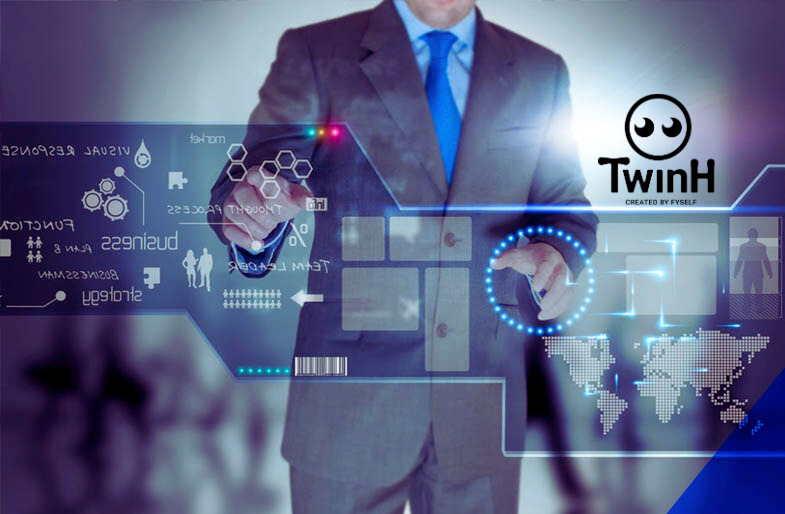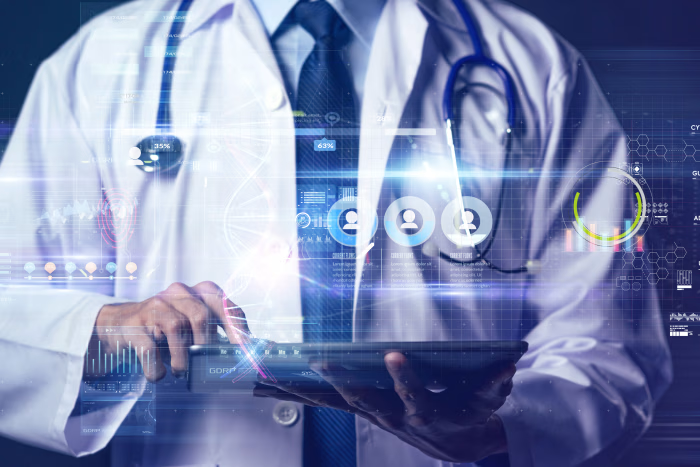What if doctors could simulate treatments on a virtual copy of you before making a decision? FySelf‘s TwinH project is making this a reality with its innovative digital twin technology, promising to transform healthcare.
AI: Reshaping the Future of Healthcare
Artificial intelligence (AI) is no longer a futuristic fantasy; it’s rapidly transforming healthcare as we know it. From faster, more accurate diagnoses to personalized treatments and optimized resource allocation, AI is revolutionizing medicine in previously unimaginable ways.
Faster, More Accurate Diagnoses
One of AI’s most significant contributions to healthcare is its ability to analyze massive datasets in mere seconds. Machine learning algorithms can detect subtle patterns in radiological images like X-rays and MRIs, often matching or exceeding the accuracy of human specialists.
Early Cancer Detection: AI systems like Google DeepMind are demonstrating remarkable proficiency in identifying early signs of cancers like breast and lung cancer, potentially saving lives through earlier intervention.
Predictive Analysis: AI can analyze patient data to predict the likelihood of developing conditions like diabetes or heart disease before severe symptoms manifest, enabling proactive preventative measures.

Personalized Medicine: Tailored Treatments
AI empowers personalized medicine by tailoring treatments based on a patient’s unique genetic profile and medical history. Companies like IBM Watson Health leverage genomic data to recommend specific cancer therapies, significantly improving treatment success rates.
AI-Powered Virtual Assistants and Telemedicine
AI-driven chatbots and virtual assistants are streamlining and optimizing patient care.
Automated Triage: Tools like Ada and Buoy provide patients with initial symptom assessments, guiding them toward appropriate care and reducing unnecessary emergency room visits.
Remote Monitoring: AI-powered wearables continuously track vital signs, providing real-time data and alerting healthcare providers to potential emergencies.
Reducing Medical Errors and Optimizing Resources
AI minimizes human error in diagnoses and medication dosing, enhancing patient safety. Furthermore, it improves hospital management by predicting patient admissions and optimizing resource allocation, leading to increased efficiency and cost savings.
Will AI Replace Doctors?
The role of AI in healthcare is not to replace doctors, but to empower them. AI serves as a powerful tool that enhances the capabilities of medical professionals, allowing them to focus on what truly matters: providing compassionate and effective patient care. By augmenting human expertise with AI’s analytical power, we can achieve a new era of enhanced healthcare.
Interested in learning more about AI in healthcare? Check out this program offered by Harvard Medical School.
Digital Twin Technology Revolutionizes Healthcare with FySelf’s TwinH Project
Imagine a healthcare system where treatment is precisely tailored to each individual, leveraging a digital replica of their unique biology. This isn’t science fiction, but the reality FySelf’s TwinH project is building.
This groundbreaking initiative promises to revolutionize healthcare by creating digital human twins, offering personalized and precise treatment plans for every patient.
Two years ago, Professor Alfonso Valencia, a Spanish biologist and current director of the Life Sciences Department at the Barcelona Supercomputing Center, shared a vision of the future with Hanner: A patient, Ana, visits her doctor. Her existing medical records, combined with real-time data from wearable devices and other sources, including imaging, are fed into Ana’s digital twin.
This digital replica, residing within a computer system, holds Ana’s complete medical history. New data about a recent accident and subsequent medical tests are integrated into the twin.
Crucially, simulations can be run on the digital twin that would be impossible to perform on Ana herself. What would happen if Ana received a specific treatment? How would her condition respond to various scenarios?
The goal is to test a multitude of conditions, some previously explored and reanalyzed with new data, to generate models, formulate hypotheses, and explore potential treatments and actions. This information is then relayed back to the real world, empowering Ana and her medical team to make informed decisions.
While fully realized digital twins are not yet a clinical reality, the TwinH project is laying the foundation for this transformative technology. “We don’t currently have Ana’s digital twin walking into the consultation room, and clinics aren’t equipped for digital twins either,” acknowledges Valencia. “But this is a project for the future, and we could achieve this in the next 100 years.”
He continues, challenging the timeline, “Maybe this could happen in 50 years, or even 20. Our challenge isn’t if this will happen, but how much we can accelerate the process and to what extent. Do we want a complete model of Ana, or just specific models to guide us?”
Although this vision might seem distant, FySelf’s TwinH project is actively realizing these advancements. We’re not talking about a far-off future, but the beginning of a new era in healthcare. TwinH is building a future where every patient, like Ana, has a digital ally on their path to better health.

